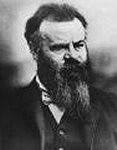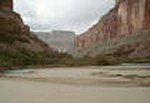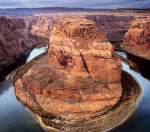| 第27课:Grand Canyon |
| http://www.sina.com.cn 2004/10/13 10:31 冰岩双语文化工作室 |
语音讲解: EXPLORATIONS – Grand Canyon By Oliver Chanler Broadcast: July 9, 2003 (((THEME))) VOICE ONE: This is Steve Ember. VOICE TWO: And this is Shirley Griffith with the VOA Special English program EXPLORATIONS. Today, we tell about a famous natural place, the Grand Canyon. (THEME) VOICE ONE:
In late September, Fifteen-Forty, a group of Spanish explorers led by Captain Garcia Lopez de Cardenas came to a stop. For weeks they had walked north across the great southwestern American desert. The land was dry. The sun was hot. They were searching for seven golden cities that they had been told about. There was not much to see on this land, just the far-away line where the sky meets the ground. Suddenly, they came to the edge of what seemed to be a huge cut in the Earth. There seemed to be no way to walk around this deep canyon. It stretched below them into the distance, to their left and right, as far as they could see. Below them and across from where they stood were strange shapes of yellow, red, brown and black rocks and stone. VOICE TWO: A small, muddy river appeared to be flowing at the bottom. Captain Cardenas ordered three of his soldiers to climb down the side of the canyon to see if they could find a way to cross to the other side. The three climbed about one-third of the way down. They found that the canyon was much deeper than they thought, so they climbed back up. Captain Cardenas and his group turned back to the south. Today, history recognizes them as the first Europeans to see the Grand Canyon, formed by the Colorado River. They had reached a place that today is considered one of the most beautiful, strange, and interesting places in the world. VOICE ONE:
European explorers did not return to the Grand Canyon for more than two centuries. Instead, native peoples continued to live there, as they had for hundreds, some of them for thousands of years. In Seventeen-Seventy-Six, two Spanish clergymen were seeking a way to travel from Santa Fe, in what is now New Mexico, to Monterey, California on the west coast of North America. Father Francisco Escalante and another clergyman were unsuccessful in their search. However, they re-discovered the Grand Canyon. VOICE TWO: During the Nineteenth Century, the population of the United States was expanding rapidly to the west. The Grand Canyon was considered a barrier to travelers. Only two places had been found where the river is low enough to cross. As settlers moved west, the United States government wanted more information about western territories. Much of the Grand Canyon was unknown. The words “Unknown Territory” were written on maps that showed the area. VOICE ONE: John Wesley Powell In May, Eighteen-Sixty-Nine, Major John Wesley Powell and nine others began the first full exploration of the Colorado River. They put four wooden boats into the water at Green River Station in Wyoming. They began their trip to where the Green River joined the Colorado River. Major Powell wrote in his book that they were beginning “the trip down the Great Unknown”. Major Powell had served in the Union army during the American Civil War. He lost his right arm in a battle during the war. After the war he became a professor of geology at Illinois Wesleyan University. He also studied paleontology, the science of life existing in different periods of Earth’s history. And he became expert in ethnology, the study of different cultures. He was the right person to explore the Grand Canyon. He was someone who could describe the geology of the area, as well as learn about the American Indians who had begun living in the canyon as many as nine-thousand years ago. Several of those tribes still consider the Grand Canyon their home. VOICE TWO: The geology of the Grand Canyon is like a history of the formation of the Earth. During millions of years, water, ice, and wind formed the canyon. Although the Grand Canyon is in the middle of a desert, water plays an important part in the way the land looks. The sun shines bright and hot almost every day. It makes the soil hard. When rain does come, it cannot sink into the soil. Instead it flows to the Colorado River. The Colorado River
Often, heavy rains cause violent floods along small rivers and streams that flow into the Colorado. These floods move huge amounts of soil and sometimes stones as big as houses. All of this material falls into the river and then is pushed along by the rapidly flowing river. This way the river slowly digs itself deeper into the rock surface of the Earth. The Colorado has been doing this for millions of years. You can see in the sides of the Grand Canyon different kinds of rock at different levels. Each of the eighteen levels was formed during a different period of Earth’s history. VOICE ONE: The ancestor of the Colorado River began flowing about seventy-million years ago. After it began flowing, volcano explosions and other natural events changed the river’s path many times. About seventeen-million years ago, pressures deep in the Earth pushed up the land through which the river flowed. The river continued to flow through the area, cutting deeper into the rock. The Grand Canyon is twenty-nine kilometers across at the widest place, and more than one and one-half kilometers deep. At the bottom of the Grand Canyon, where the river flows today, the rock is almost two-thousand-million years old. VOICE TWO: In Eighteen-Sixty-Nine, not many people expected John Wesley Powell and his team of explorers to survive the trip through the Grand Canyon. No one had ever done it before. There are many dangers on the fast-moving river. Rocks hidden under the water can smash small boats. In places where the river is narrow, the water becomes violent as it rushes between high rock walls. Also, there are rapids of fast moving water in places where the river drops to a lower level. In some places, strong currents can push a boat into rocks in the water, or against the walls of the canyon. Major Powell knew the trip would be dangerous. When the boats came near a rapid, he and his crew would stop. Sometimes they decided to go through by rowing the boats with their oars, as they did in calm water. At other times they carried the boats and all their equipment around dangerous rapids. Major Powell wrote every day in a book about what they did and saw. This is how he described the difficulties of one day: VOICE THREE: “We carried the boats around rapids two times this morning... During the afternoon we ran a narrow part of the river, more than half a mile in length, narrow and rapid. We float on water that is flowing down a gliding plane. At the bottom of the narrow part of the river, the river turns sharply to the right, and the water rolls up against a rock that seems to be in the middle of the stream. We pull with all our power to the right, but it seems impossible to avoid being carried against the cliff, and we are carried up high on the waves – not against the rocks, for the water strikes us and we are pushed back and pass on with safety...” VOICE ONE:
More than three months after starting, Major Powell and his group reached the end of the Grand Canyon. Three men had left the group earlier and were never seen again. Two of the men in the group continued down the river to the sea, becoming the first people known to have traveled the entire length of the Colorado River. VOICE TWO: Today, the Grand Canyon is in a national park. About five-million people visit it each year. They stop at its edge and look in wonder at a place that can create great emotions in those seeing it. Others walk down the many paths into the canyon. Some ride rubber boats down the Colorado River through the Grand Canyon. River guides are experts at taking the boats through the most violent rapids. This activity, called white-water rafting, is very popular. VOICE ONE: Generally, the trip takes about two weeks in boats that carry three or four people. Bigger boats with motors that carry about twenty people can make the trip in several days. As people float down the river, they see the many wonderful and strange shapes created by the forces of nature. They may see animals, such as bighorn sheep, and coyotes. They experience the excitement of traveling through white-water rapids, and sleeping under the stars. The sound of the river is always present, sometimes loud, sometimes soft. After several days traveling on and sleeping near the river as it flows through the Grand Canyon, many visitors say they feel their cares and worries leave them. Their concerns are replaced by a feeling of wonder about the canyon and the powers of nature. (THEME) VOICE TWO: This program was written by Oliver Chanler and produced by Paul Thompson. This is Shirley Griffith. VOICE ONE: And this is Steve Ember. Join us again next week for another EXPLORATIONS program in Special English on the Voice of America. 出处:《美国之音慢速英语经典》系列光盘产品 BiCulture工作室(www.biculture. com) 编辑:趴趴 |
【评论】 |
| 【英语学习论坛】【大 中 小】【打印】【关闭】 |



